Key Takeaways
- A perfectly roasted turkey requires about 1 pound per person for regular portions and 1.5 pounds per person if you want leftovers
- Prepare about 1/2 cup of stuffing per person when planning your Thanksgiving meal, but consider making extra for this popular side dish
- Side dishes like vegetable platters can be prepared up to 24 hours ahead of time to reduce stress and maximize kitchen space
- Traditional Thanksgiving recipes can be improved with modern twists like cheesy kale stuffing while keeping the familiar flavors guests expect
- Proper planning is key for a successful Thanksgiving feast—start organizing at least one week in advance
- Dietary needs can be easily included in your menu with simple substitutions and clear labeling
- Make-ahead preparations turn what could be an overwhelming cooking day into an enjoyable celebration
The Heart of Thanksgiving: A Traditional Feast
Thanksgiving brings families together around tables filled with beloved dishes passed down through generations. At Whaley Cooks, we know that creating the perfect Thanksgiving feast needs both traditional recipes and good planning. Whether you’re hosting for the first time or wanting to refresh your holiday menu, our comprehensive guide to traditional Thanksgiving recipes will help you create a memorable celebration that honors both old traditions and new tastes.
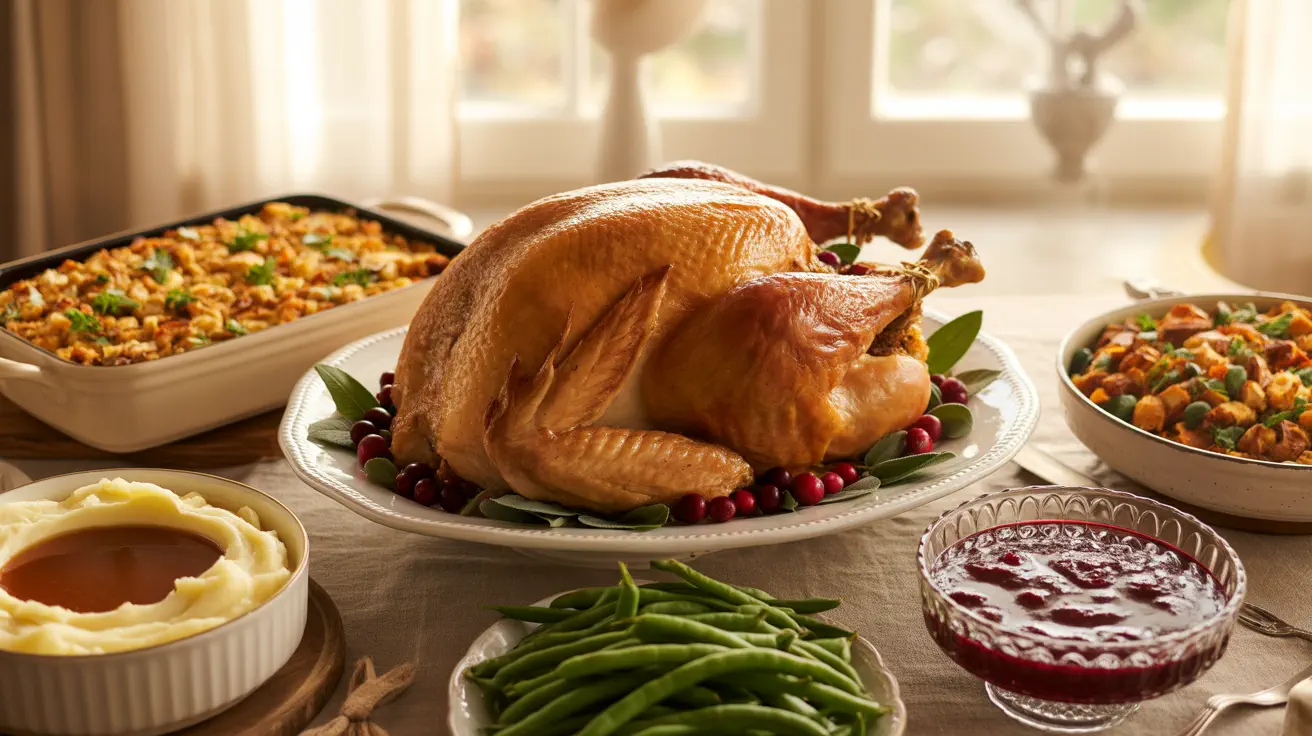
The perfect Thanksgiving balances timeless traditions with new ideas. While we love classic recipes like roast turkey and pumpkin pie, there’s always room to try new flavors that might become tomorrow’s traditions. Our guide covers everything from appetizers to desserts, making sure your holiday table has something for everyone—from people who want the same menu every year to those who like trying new things.
When planning your Thanksgiving menu, try making some dishes ahead of time. This helps reduce stress on the big day and lets you enjoy the celebration with your guests. Many of our traditional recipes have parts that can be made in advance and still taste great when reheated. By spreading your cooking over several days, you’ll turn what could be a stressful cooking marathon into an enjoyable experience that ends with a great meal shared with people you care about.
1. The Perfect Roast Turkey: Centerpiece of Tradition
No Thanksgiving table is complete without a beautifully roasted turkey in the middle. This important dish needs careful planning, from picking the right size bird to cooking it so the meat is moist and the skin is crispy. The perfect turkey looks good and tastes delicious, creating an unforgettable centerpiece that honors the holiday’s most cherished tradition.
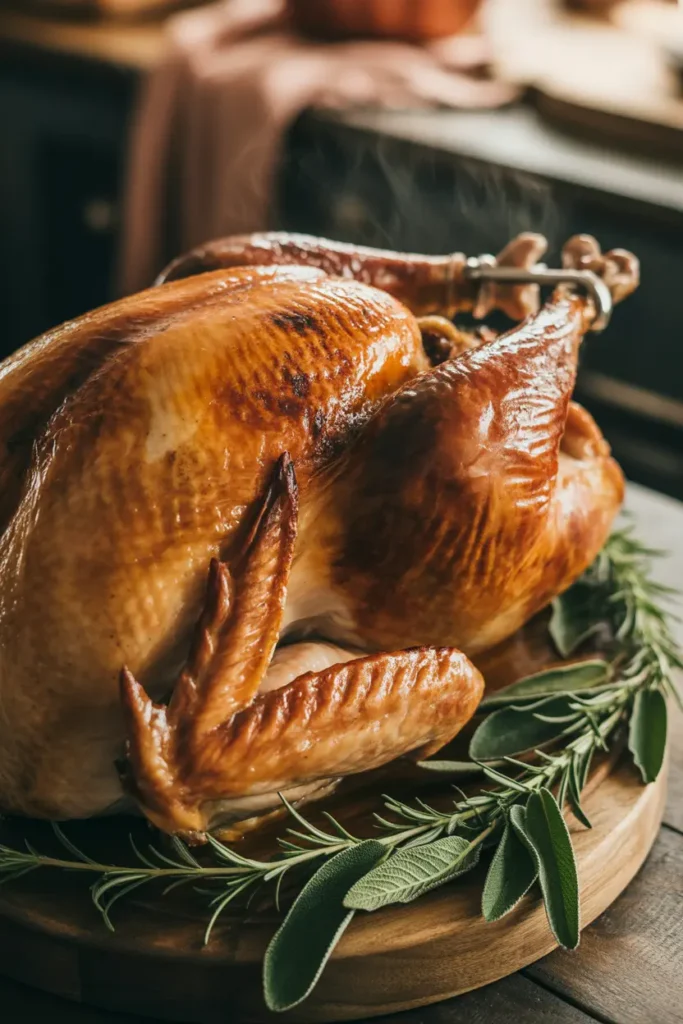
Selecting the Right Size Turkey
One of the most common questions when preparing for Thanksgiving is how much turkey to buy. As a general rule, plan for about 1 pound of turkey per person if you want everyone to have enough with some leftovers. For 10 people, a 10-12 pound turkey should be enough. If you want plenty of leftovers (great for sandwiches, soup, or pot pie the next day), aim for 1.5 pounds per person. Remember that bones and giblets make up about 20-30% of the turkey’s weight but aren’t edible meat.
Traditional Roasting Method
For the most traditional way to prepare turkey, follow these key steps:
- Fully thaw your turkey if frozen (allow about 24 hours in the refrigerator for every 4-5 pounds)—a 15-pound turkey needs about 3-4 days to thaw completely
- Make a simple herb butter with sage, thyme, and rosemary to rub under and over the skin—this adds flavor directly to the meat while helping the skin get golden and crispy
- Season the inside generously with salt and pepper, and add things like onion quarters, lemon halves, and fresh herb sprigs
- Roast at 325°F until a meat thermometer inserted into the thickest part of the thigh reads 165°F without touching bone
- Let the turkey rest for at least 20-30 minutes before carving so the juices spread throughout the meat, making it more tender and flavorful
Remember that cooking times vary based on the size of your bird, with a general rule of about 15 minutes per pound for an unstuffed turkey. Using a good meat thermometer is the most accurate way to make sure your turkey is properly cooked while staying juicy and tender. For better flavor and moisture, consider brining your turkey 12-24 hours before roasting—a simple mixture of salt, sugar, and water with herbs and spices can really improve both taste and texture.
2. Classic Stuffing Variations: From Traditional to Innovative
Stuffing (or dressing, if cooked outside the bird) is perhaps the most versatile and loved side dish on the Thanksgiving table. While traditional bread stuffing remains popular, there are many variations to try, each offering unique flavors and textures that go well with roasted turkey. Different regions across America have their own versions, from cornbread in the South to sourdough in San Francisco, creating different takes on this essential holiday dish.
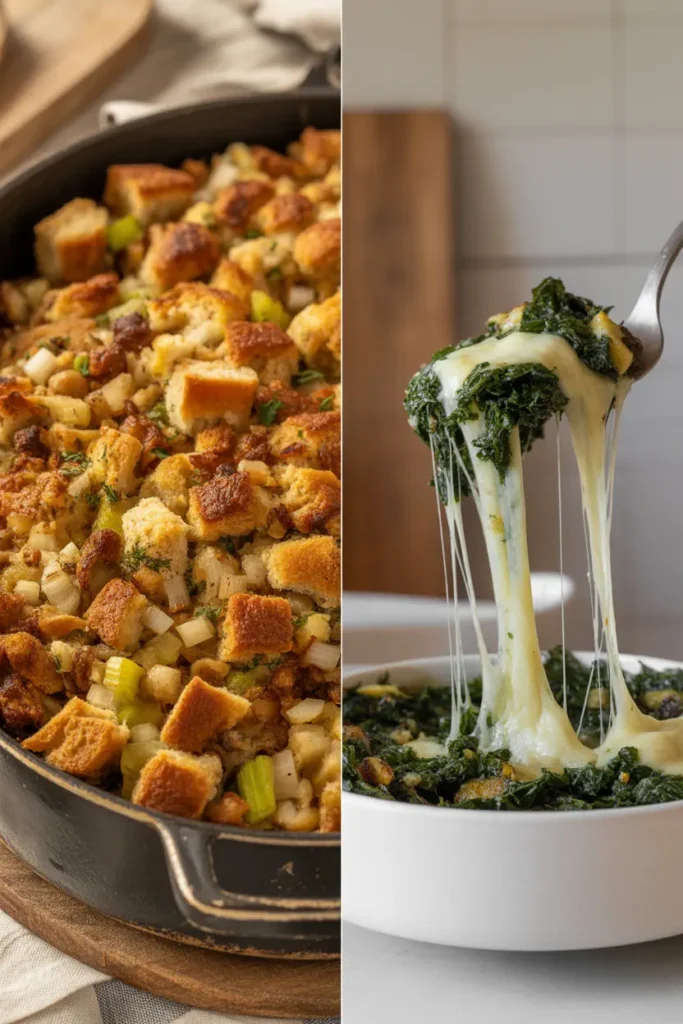
Portion Planning for Stuffing
When making stuffing for your Thanksgiving gathering, a good rule of thumb is to plan for about 1/2 cup of stuffing per person. But since stuffing is so popular, you might want to make a bit extra – many guests will happily take seconds of this favorite side dish. For 10 people, preparing 6-8 cups of stuffing makes sure everyone gets enough. Remember that stuffing tends to be one of the first leftovers to disappear, so making too much is rarely a problem.
The classic bread stuffing mixes dried bread cubes with cooked onions, celery, herbs (especially sage, thyme, and parsley), and chicken or turkey broth. The mixture is baked until golden and crisp on top while staying moist inside. This basic recipe can be improved with additions like sausage, dried fruits, or nuts. For the best texture, use day-old bread or dry fresh bread cubes in a low oven before mixing with other ingredients. The bread should be dry enough to soak up the flavorful liquid without getting soggy.
For a modern twist on traditional stuffing, try our Spectacular Thanksgiving Cheesy Winter Green Stuffing with Kale. This recipe includes nutritious kale with rich cheese for a stuffing that’s both tasty and healthy. The earthy flavors of kale go well with traditional Thanksgiving ingredients while adding bright color to your holiday table. The sharp cheddar or gruyère cheese creates pockets of creaminess throughout the stuffing, making this side dish a potential favorite among your guests.
3. Essential Side Dishes: Completing the Thanksgiving Spread
A traditional Thanksgiving feast is defined as much by its side dishes as by the turkey itself. These supporting players bring color, texture, and complementary flavors to the meal, creating a balanced combination that makes the holiday table so special. From creamy mashed potatoes to tangy cranberry sauce, these classics are often the dishes that guests most look forward to enjoying year after year.

Creamy mashed potatoes are perfect for rich turkey gravy. For the fluffiest mashed potatoes, choose starchy types like Russets or Yukon Golds. Warm your milk and butter before adding them to the potatoes, and don’t mix too much, which can make potatoes gluey. Adding some chicken broth to your gravy gives deeper flavor that goes well with the turkey. For extra-special mashed potatoes, try adding roasted garlic, sour cream, or cream cheese. The gravy can be improved with herbs like thyme and sage, or even a splash of white wine or sherry for more complex flavor.
Balance the richness of your Thanksgiving meal with bright green vegetables. Roasted Brussels sprouts with bacon, green beans almondine, or a simple salad with seasonal ingredients can add welcome freshness. Our side dish collection offers many options to include healthy vegetables in your feast. Consider making vegetables that can be served at room temperature, such as roasted asparagus with lemon zest or a shaved Brussels sprout salad with cranberries and pecans, to reduce the need for last-minute reheating and free up valuable oven space.
4. Vegetable Platters: Fresh Additions to the Thanksgiving Table
A well-prepared vegetable platter offers a refreshing contrast to the richness of traditional Thanksgiving food while accommodating guests with dietary preferences. These colorful displays provide a nice contrast in color, texture, and temperature to the mostly warm, cooked dishes that fill the holiday table. They also work as an excellent appetizer that won’t fill people up before the main meal.
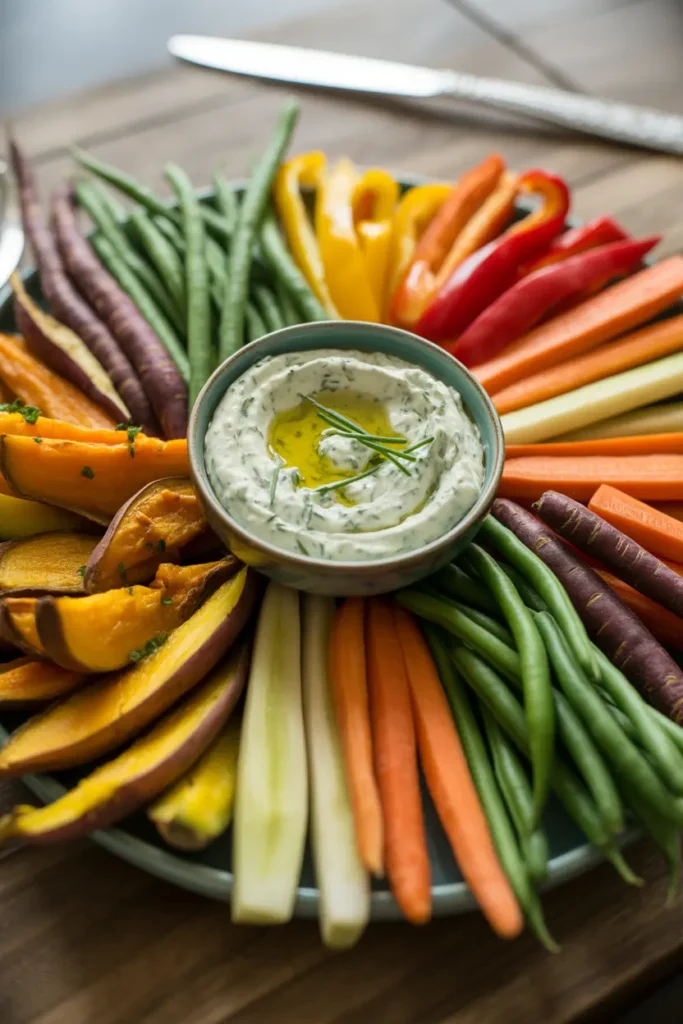
Planning a Crowd-Pleasing Vegetable Platter
Creating a vegetable platter to feed a crowd is both practical and impressive. Unlike hot dishes that need last-minute attention, a vegetable platter can be made hours ahead and kept fresh in the refrigerator. This make-ahead quality is especially valuable on Thanksgiving when oven and stovetop space is limited. A well-designed vegetable platter also works as an edible centerpiece, adding visual appeal to your holiday buffet while providing a lighter option for guests to enjoy throughout the gathering.
Selecting Seasonal Vegetables
For a Thanksgiving-appropriate vegetable platter, include seasonal produce like:
- Roasted sweet potato wedges with cinnamon and sea salt
- Blanched green beans tossed with a light vinaigrette and chilled
- Rainbow carrots in their natural bright colors of purple, yellow, and orange
- Brussels sprout halves (lightly steamed) for an unexpected but seasonal addition
- Roasted cauliflower florets seasoned with spices like cumin and paprika
- Bell peppers in fall colors (red, orange, yellow) for visual appeal and sweet flavor
Arrange vegetables by color for visual appeal, and consider including some items at room temperature and others chilled for texture variety. This temperature contrast provides interest and accommodates different preferences among your guests. Consider adding herbs like rosemary sprigs or sage leaves as both decoration and aromatic elements that reinforce the seasonal theme.
5. Traditional Thanksgiving Desserts: Sweet Endings
No Thanksgiving feast is complete without traditional desserts. While pumpkin pie may be the most iconic, a variety of sweet offerings ensures everyone finds something they like. These desserts often feature seasonal ingredients like pumpkin, apple, and pecans, celebrating the harvest season while providing a comforting end to the celebratory meal.

Pumpkin pie captures the flavors of fall with its warm spices and smooth texture. A traditional pumpkin pie has a filling of pumpkin puree, eggs, condensed milk, and spices (cinnamon, ginger, nutmeg, and cloves) in a flaky pastry crust. For best results, bake your crust a bit before adding the filling to prevent sogginess, and let the pie cool completely before serving with freshly whipped cream. Consider roasting your own pumpkin for a deeper, more complex flavor than canned puree, or try alternative squashes like butternut or kabocha for subtle variations on the classic.
Rich and decadent, pecan pie offers a delightful contrast to pumpkin with its caramelized filling and crunchy nut topping. The classic recipe combines pecans with a filling of eggs, butter, sugar, and corn syrup or maple syrup. For a twist on tradition, consider adding a tablespoon of bourbon or a handful of chocolate chips to the filling. Some bakers toast the pecans before adding them to the pie for enhanced nuttiness, while others use brown butter for a sophisticated flavor that makes this Southern classic even more delicious.
6. Thanksgiving Beverages: From Appetizers to Dessert
Well-chosen beverages complement each stage of your Thanksgiving celebration, from pre-dinner socializing through the main meal and dessert. A good beverage menu enhances the dining experience, cleanses the palate between courses, and adds another layer of seasonal enjoyment to your gathering.

Greet guests with warming drinks that set a festive mood. Mulled apple cider (which can be made with or without alcohol) fills your home with inviting smells of cinnamon, cloves, and allspice. For a special touch, offer a signature cocktail featuring seasonal ingredients like cranberry, apple, or pear. Consider making a large batch of mulled cider in a slow cooker, letting guests serve themselves throughout the gathering while keeping the perfect temperature and freeing you to focus on other hosting duties.
Our science of flavor guide for drinks can help you create balanced and memorable beverage options that complement your Thanksgiving menu. Understanding how to balance sweet, sour, bitter, and aromatic elements results in sophisticated drinks that enhance rather than overwhelm the complex flavors of your holiday feast.
7. Accommodating Dietary Restrictions at the Thanksgiving Table
Today’s Thanksgiving gatherings often include guests with various dietary needs and preferences. Thoughtful menu planning ensures everyone can enjoy the celebration without feeling left out or needing special attention. With small changes to traditional recipes, hosts can create an inclusive feast where every guest feels welcomed and considered.
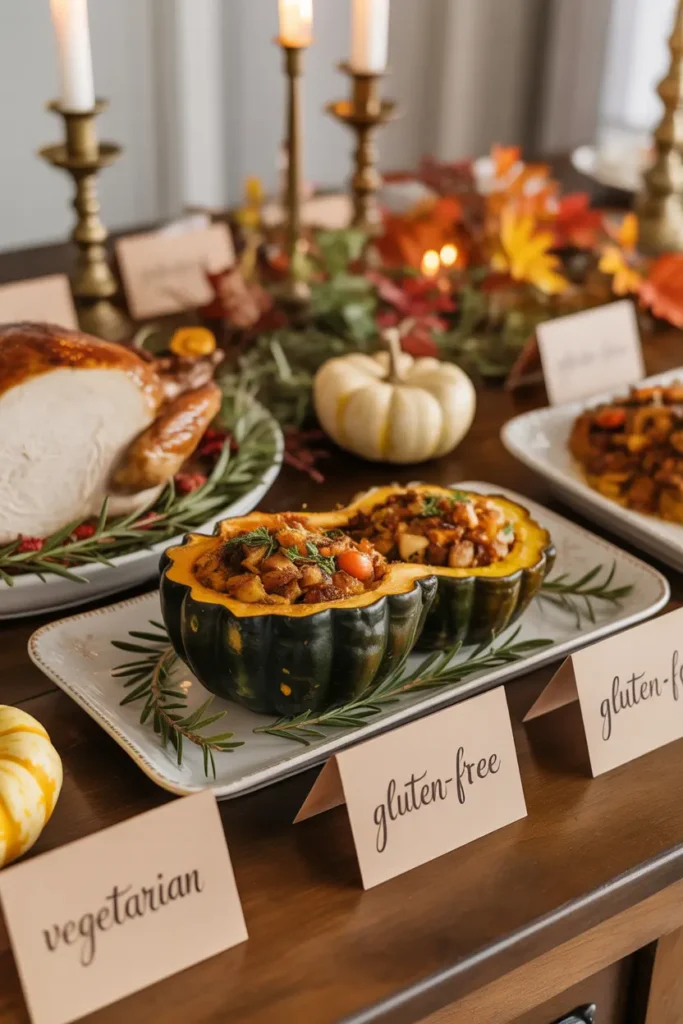
For guests who don’t eat meat, consider making:
- Stuffed acorn squash with wild rice and cranberries, providing an impressive main dish with seasonal flavors
- Mushroom Wellington with gravy, offering the satisfying umami flavor and festive presentation that vegetarians might miss from the turkey
- Lentil and vegetable shepherd’s pie topped with creamy mashed potatoes or sweet potatoes for a hearty, protein-rich alternative
- Cheesy kale stuffing (for vegetarians) or a version with nutritional yeast (for vegans) that provides the traditional stuffing experience without animal products
Many traditional sides can be easily adapted for vegetarian or vegan diets by using vegetable broth instead of chicken broth and plant-based butter instead of dairy butter. These simple swaps keep the familiar flavors guests expect while meeting dietary needs without creating extra work for the host.
8. Make-Ahead Strategies for a Stress-Free Thanksgiving
One of the secrets to hosting a successful Thanksgiving is planning ahead. Many traditional dishes can be partially or completely prepared days before the holiday, turning what could be an overwhelming cooking marathon into a manageable sequence of tasks that allows the host to enjoy the celebration with guests.

Three days before Thanksgiving, start your preparations by:
- Making and freezing pie crusts, which will actually benefit from the rest period and thaw quickly
- Preparing cranberry sauce, which develops deeper flavor over several days in the refrigerator
- Cubing and drying bread for stuffing, allowing it to reach the perfect texture for absorbing flavorful liquids
- Making and freezing soups or appetizers that can be easily reheated without quality loss
- Creating a detailed shopping list and cooking timeline, including oven scheduling to ensure everything is ready at the same time
This smart approach turns what could be an overwhelming day of cooking into a more manageable and enjoyable celebration. By spreading tasks across multiple days, you’ll reduce stress, minimize timing problems, and ensure each part of your feast gets the attention it deserves.
Conclusion: Celebrating Tradition While Creating New Memories
Traditional Thanksgiving recipes provide a comforting framework for this beloved holiday, connecting us to our shared heritage while allowing for personal expression and growth. Whether you’re cooking for two or twenty, the heart of Thanksgiving lies in gathering together with thankfulness and celebrating the bonds of family and friendship over a thoughtfully prepared meal that honors both tradition and new ideas.

At Whaley Cooks, we believe the most meaningful Thanksgiving celebrations balance cherished traditions with thoughtful new ideas. Our comprehensive Thanksgiving recipe collection offers both classic preparations and fresh interpretations like our Spectacular Thanksgiving Cheesy Winter Green Stuffing with Kale. These recipes honor the spirit of traditional Thanksgiving cooking while including modern ingredients and techniques that reflect changing tastes and dietary preferences.
Remember that the perfect Thanksgiving isn’t about making every dish perfectly, but rather about creating a warm, welcoming atmosphere where loved ones can connect. Good planning allows the host to enjoy the celebration with guests, while make-ahead strategies reduce stress on the day. The most memorable Thanksgiving gatherings often feature a mix of old family recipes alongside new discoveries that might become tomorrow’s traditions.
Whether you’re keeping generations-old family recipes or starting new traditions, we hope this guide helps you create a Thanksgiving celebration that reflects your personal style while honoring the spirit of gratitude that defines this special holiday. The beauty of Thanksgiving is in its adaptability—each family creates its own unique version of the feast while maintaining connections to shared cultural traditions that unite us across generations and geography.


